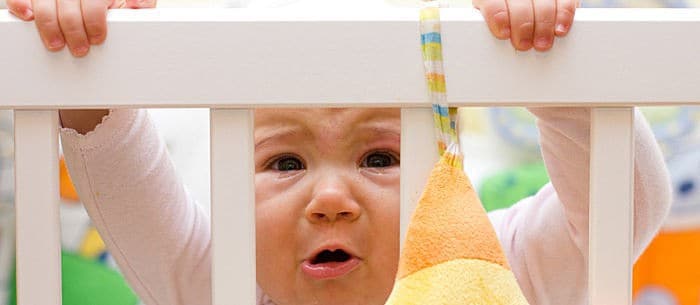When it comes to getting your baby to go to sleep, there are countless different methods used by parents. Each baby and family situation is different, meaning that it’s impossible to find one perfect solution to fit everyone. However, one of the most popular – and hotly contested – methods is ‘self-soothing’ or ‘crying-it-out’. Here’s a walkthrough of this more controversial method to help you decide what works for your family.
The Method: What Is Self-Soothing?
Proponents of self-soothing believe that falling asleep on your own is a skill that your baby can learn when given the opportunity. The idea is that if your child gets used to being rocked or nursed to sleep, they won’t learn to go to sleep on their own.
The true self-soothing method — also known as the extinction method — involves putting your baby down in their cot while they’re still awake, giving their a gentle pat on the back and leaving the room until morning. You can expect lots of crying until your little one learns to settle themselves down for the night.
The Ferber method has become practically synonymous with crying-it-out, with a slight difference: As with the extinction method, you put your baby to bed while they’re awake and leave the room. However, with the Ferber method, you wait a predetermined amount of time before going back in to soothe your little one. Throughout the night, you increase the amount of time between visits — such as five-, ten- and then fifteen-minute intervals.
Pros and Cons
Using ‘crying-it-out’ is often one of the quickest sleep training methods, with most parents seeing results in three or four nights. Babies practice self-soothing skills and learn them quickly. Additionally, while it may sound distressing, many experts believe that self-soothing doesn’t cause emotional or psychological stress on little ones. Toxic stress can be categorised as children being emotionally or physically abused. As long as their needs are being met, they will be fine crying for a few nights.
Though your child will be fine, you might not be. It can be very distressing for parents to hear their baby cry; this could lead to less consistency — in other words, going back in to soothe your child when using the extinction method — which could confuse your child and cause them to regress.
Some experts do believe that letting your baby cry can have negative effects on their development. There is the possibility of detachment and distrust between infant and parent. The infant’s trust in the parent as a source of comfort and security has the potential to diminish. There is also the possibility that parents may not search for an underlying reason for their child’s cries when using the self-soothing method, which could leave potential issues undiagnosed.
Age and Environment Matter
Any sleep-training method may not be safe until your child is 4 to 6 months old. Before this age, they are not able to self-soothe because their circadian rhythms are not yet developed. Always set up your baby for ideal sleep. Keep your little one’s room dark, quiet and cool. Make sure that your baby has plenty of naps throughout the day and has an age-appropriate bedtime: your 4-month-old should sleep for six to eight hours at a time and up to 12 hours by 6 months. So a bedtime between 19:30 and 20:00 for little ones of this age is ideal. Also, prepare for some tears whenever you sleep train. Regardless of the sleep method you choose for your child, crying is inevitable because you’re teaching new skills.
* This article is for general informational purposes only. It is not intended nor implied to be providing medical advice and is not a substitute for such advice. The reader should always consult a health care provider concerning any medical condition or treatment plan. Neither Care.com nor the author assumes any responsibility or liability with respect to use of any information contained herein.
